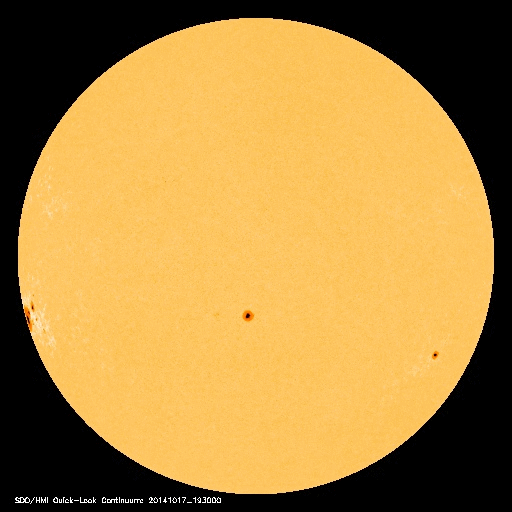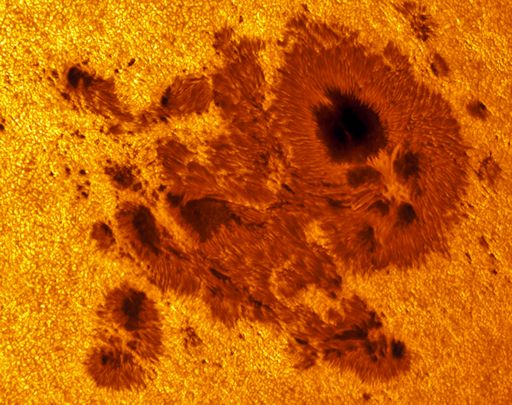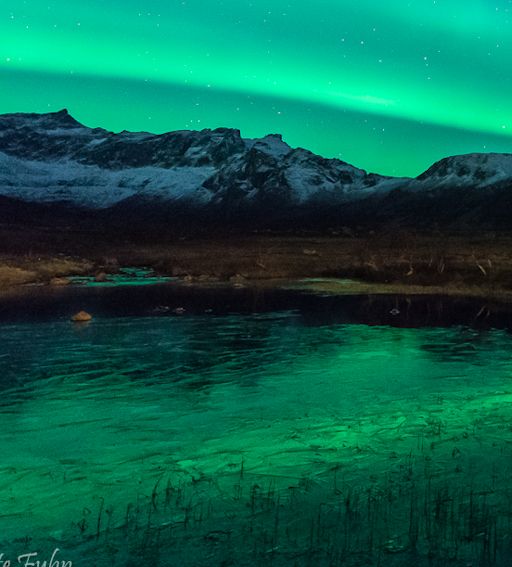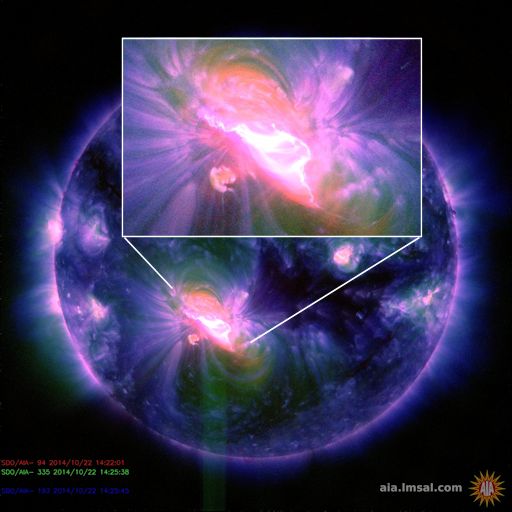Daily Suspicious0bserver's Weather Post:
October 20, 2014
What's in the sky tonight?
October 20, 2014
-Big sunspot AR2192 has grown even bigger, spreading across 1/3rd more solar terrain today than it did yesterday. NASA's Solar Dynamics Observatory recorded the expansion. The chances of an explosion are growing along with the sunspot. On Oct. 20th, NOAA forecasters boosted the odds of an M-class flare to 60% and an X-flare to 20%.
Yesterday, the sunspot produced a long-duration X1-flare and a strong HF radio blackout over Asia and Australia. The next X-flare, if one occurs, will be even more geoeffective as the sunspot turns toward Earth.
If you have a solar telescope, now is a great time to look at the sun. AR2192 looks absolutely spectacular.
 Astro Picture of the Day:
October 20, 2014
Source:
Astro Picture of the Day:
October 20, 2014
Source:
Yesterday, a comet passed very close to Mars. In fact, Comet C/2013 A1 (Siding Spring) passed closer to the red planet than any comet has ever passed to Earth in recorded history. To take advantage of this unique opportunity to study the close interaction of a comet and a planet, humanity currently has five active spacecraft orbiting Mars: NASA's MAVEN, MRO, Mars Odyssey, as well as ESA's Mars Express, and India's Mars Orbiter. Most of these spacecraft have now sent back information that they have not been damaged by small pieces of the passing comet. These spacecraft, as well as the two active rovers on the Martian surface -- NASA's Opportunity and Curiosity -- have taken data and images that will be downloaded to Earth for weeks to come and likely studied for years to come. The featured image taken yesterday, however, was not taken from Mars but from Earth and shows Comet Siding Spring on the lower left as it passed Mars, on the upper right.
Daily Suspicious0bserver's Weather Post:
October 21, 2014
What's in the sky tonight?
October 21, 2014
-The biggest sunspot of the current solar cycle is turning toward Earth. This morning when astronomer Karzaman Ahmad of Malaysia's Langkawi Nagtional Observatory looked through the eyepiece of his solar telescope, he declared AR2192 a "monster" and snapped this picture. This behemoth active region is 125,000 km wide, almost as big as the planet Jupiter. These dimensions make it an easy target for backyard solar telescopes.
A few days ago, AR2192 unleashed an X1-class solar flare. Since then the sunspot has almost doubled in size and developed an increasingly unstable 'beta-gamma-delta' magnetic field. It would seem to be just a matter of time before another strong explosion occurs. NOAA forecasters estimate at 60% chance of M-class flares and a 20% chance of X-flares on Oct. 21st.
-A high-speed stream of solar wind is buffeting Earth's magnetic field, sparking bright lights around both poles. "This evening the auroras appeared everywhere," reports Anne Birgitte Fyhn, who photographed the display from a pond on Kval°ya island, Troms°, Norway. "They were amazing," she says. "I ran around the pond a couple of times taking pictures from different spots. Finally, I decided to just sit down, look up, and enjoy the show."
High-latitude sky watchers should remain alert for auroras on Oct. 21-22. NOAA forecasters estmate a 45% chance of geomagnetic storms as the solar wind continues to blow.

 Astro Picture of the Day:
October 21, 2014
Source:
Astro Picture of the Day:
October 21, 2014
Source:
Whatever hit Mimas nearly destroyed it. What remains is one of the largest impact craters on one of Saturn's smallest moons. The crater, named Herschel after the 1789 discoverer of Mimas, Sir William Herschel, spans about 130 kilometers and is pictured above. Mimas' low mass produces a surface gravity just strong enough to create a spherical body but weak enough to allow such relatively large surface features. Mimas is made of mostly water ice with a smattering of rock - so it is accurately described as a big dirty snowball. The above image was taken during the 2010 February flyby of the robot spacecraft Cassini now in orbit around Saturn. A recent analysis of Mimas's unusual wobble indicates that it might house a liquid water interior ocean.
Daily Suspicious0bserver's Weather Post:
October 22, 2014
What's in the sky tonight?
October 22, 2014
-Solar activity is high. During the past 48 hours, monster sunspot AR2192 has produced a series of seven M-class solar flares of increasing intensity. The eruptions crossed the threshold into X-territory with an X1-class flare on Oct. 22nd. NASA's Solar Dynamics Observatory recorded a powerful flash of extreme UV radiation in the sunspot's magnetic canopy at 14:30 UT. Remarkably, not one of the explosions so far has hurled a significant CME toward Earth. The primary effect of the flares has been to ionize Earth's upper atmosphere, causing a series of short-lived HF radio communications blackouts. Such blackouts may be noticed by amateur radio operators, aviators, and mariners.
Earth-effects could increase in the days ahead. AR2192 has an unstable 'beta-gamma-delta' magnetic field that harbors energy for powerful explosions, and the active region is turning toward Earth. NOAA forecasters estimate at 65% chance of M-class flares and a 20% chance of X-flares during the next 24 hours. Solar flare alerts: text, voice
AR2192 is shaping up to be the biggest sunspot in many years. Its area is now approaching that of AR0486, the last great sunspot of the previous solar cycle, which covered 2610 millionths of the solar disc on Oct. 30, 2003. As of 0h UT today AR 2192 is 2410 millionths. (Thanks to Geoff Chester of the US Naval Observatory for this comparison.) The sun face from October 30, 2003 is shown below side-by-side with the sun face today for comparison.
Because the sunspot is so large--now about as wide as the planet Jupiter--people are beginning to notice it at sunset when the sun is dimmed by clouds or haze. Pilot Brian Whittaker took this picture on Oct. 21st while flying 36,000 ft over Resolute, Nunavut, Canada. "I was impressed to photograph the giant sunspot as the sun set over Arctic Canada," says Whittaker. "Actually, the sun was temporarily rising because of our great relative speed over the lines of longitude at N75 degrees! Note the green upper rim."



 Astro Picture of the Day:
October 22, 2014
Source:
Astro Picture of the Day:
October 22, 2014
Source:
One of the largest sunspot groups in recent years is now crossing the Sun. Labelled Active Region 2192, it has already thrown a powerful solar flare and has the potential to produce more. The featured video shows a time lapse sequence of the Sun in visible and ultraviolet light taken yesterday and incorporating the previous 48 hours. AR 2192, rotating in from the left, rivals Jupiter in size and is literally crackling with magnetic energy. The active Sun has caused some spectacular auroras in recent days, and energetic particles originating from AR 2192 may help continue them over the next week. Tomorrow, the Sun will appear unusual for even another reason: a partial solar eclipse will be visible before sunset from much of North America.
Daily Suspicious0bserver's Weather Post:
October 23, 2014
What's in the sky tonight?
October 23, 2014
-On Thursday, Oct. 23rd, the Moon will pass in front of the sun, off center, producing a partial solar eclipse visible from almost all of North America. This animated visibility map shows when to look. LINK:
http://shadowandsubstance.com/ The event will be particularly beautiful in the Central and Eastern time zones where maximum eclipse occurs at sunset.
The farther north and west you are, the deeper Thursday afternoon's partial solar eclipse will become.

 Astro Picture of the Day:
October 23, 2014
Source:
Astro Picture of the Day:
October 23, 2014
Source:
This wide, sharp telescopic view reveals galaxies scattered beyond the stars and faint dust nebulae of the Milky Way at the northern boundary of the high-flying constellation Pegasus. Prominent at the upper right is NGC 7331. A mere 50 million light-years away, the large spiral is one of the brighter galaxies not included in Charles Messier's famous 18th century catalog. The disturbed looking group of galaxies at the lower left is well-known as Stephan's Quintet. About 300 million light-years distant, the quintet dramatically illustrates a multiple galaxy collision, its powerful, ongoing interactions posed for a brief cosmic snapshot. On the sky, the quintet and NGC 7331 are separated by about half a degree.